TaPRK
General
Projects
Shows
Excursions
Links
Yleistä
Ratoja
Projektit
Näyttelyt
Retket
Linkit
Parish/SRK
Tapiola Parish Model Railway ClubKauniainen, Bugs |
|---|
Model Expo 2004 problems...
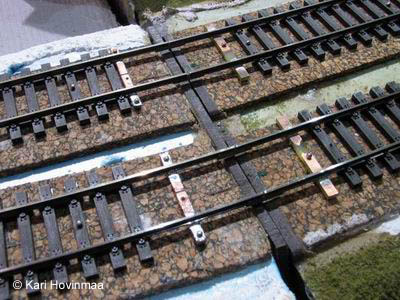
This is what the module joint should have looked like. Three original sleepers away and one PCB-sleper (plus two loweed sleepers to make space for rail joiners). The idea is that the rail head is flexible to adjust to slight misalignment, yet still be held in line with rail joiners.
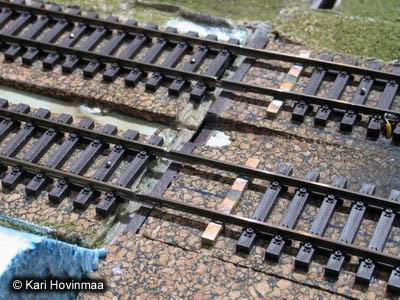
Unfortunately not all modules were prepared for rail joiners.
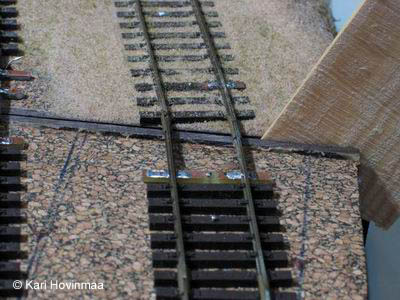
We need to be more precise with laying of track now as we don't have the bridging rails. Here Pekka has re-railed Kauniainen goods yard to move the insulations. Although the right hand track ends meet the module faces won't. Too long rail end prevents bringing the modules close enough (approx 2mm piece of wood fits between module frames.
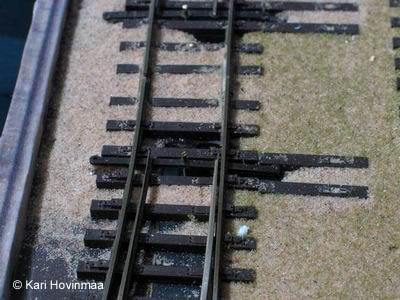
Biltema car relays are no good as point motors with Pilz (Tillig) Elite turnouts with flexible point blade fixing. There is not enough force. Also during ballasting some sand has found it's way between moving parts of the relay so that the movement is limited.
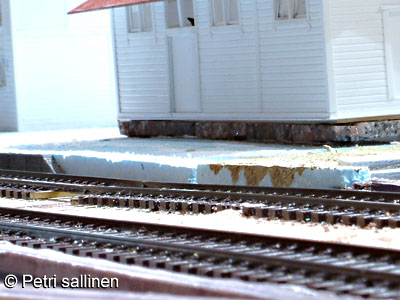
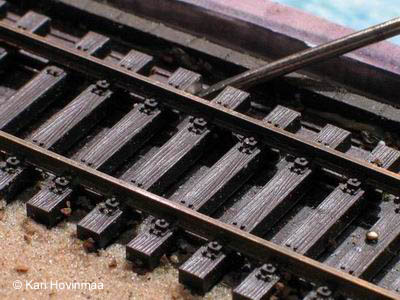
Tunnelitie underpass was covered with 3 mm (1/8") styrene sheet. The track wasn't properly fastened to bridge deck thus it buckled.
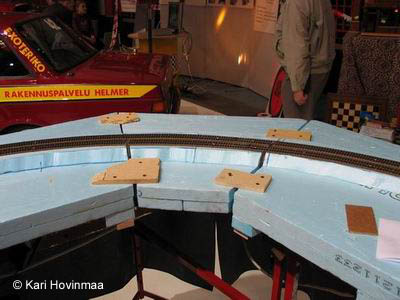
The construction of corner modules from three parts was -- and still is -- a challencing project! As the aluminium tubes weren't tight enough inside the plastic tubes glued inside the module, the joints needed to be fastened somehow to get over the exhibition. we just attached temprary splice plates across the joints...
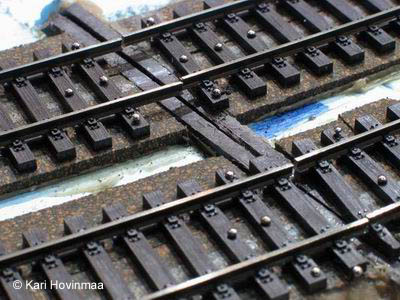
... but still the joint wasn't good enough. The plan is not to use ral joiners at the corner modules internal joints!
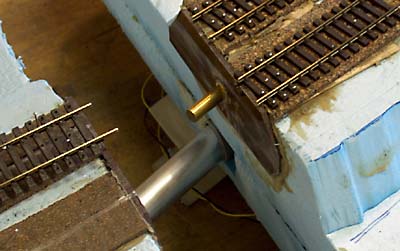
Repairs: For better alignment we are testing a idea of the non-modular internal joints being being fitted with pins: 8/10 mm brass tubes are glued with epoxy and 8 mm brass pin is used for alignment -- yet only one pin per joint.
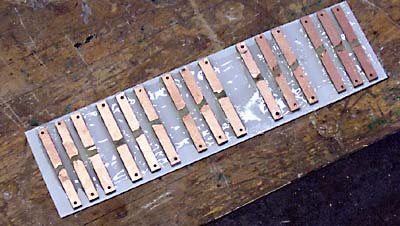
Pcb sleepers are only 1,5 mm thick whereas the Tillig sleepers are 2 mm thick. Therefore the pcb-sleepers need to be shimmed with half a millimetre styrene. Here are the prepared pcb-sleeper sets glued together with epoxy.
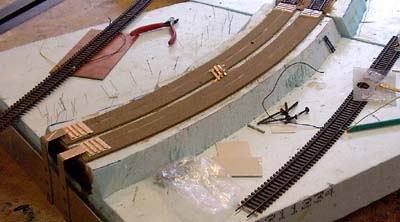
The pcb-sleepers are fitted with the shim, and pinned down. The track will be relaid and soldered to pcb sleepers. the Modular joint has the track position is ensured with a jig. The middle section of corner module has the insulated joint. More pcb sleepers are needed there.
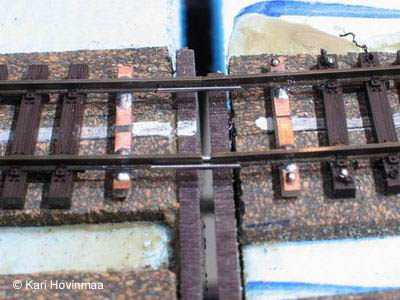
Again a joint where too long rail ends prevent joining the modules properly!
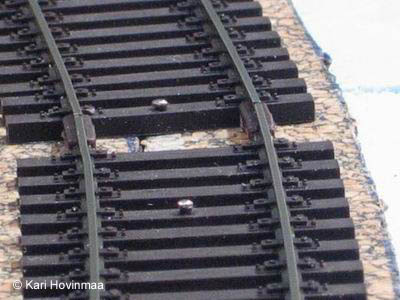
As all module joints will be equipped with rail joiners the block sections need to be located somewere within the module (approx midway). The sectionalizing of the layout is neccessary in order to get signalling to work and also to divide the layout into booster districts. The insulated joiners are planned to be located in the middle of the module. With corner modules this is a problem as the plastic joiners wont keep the track straigt without a lot of extra spikes. The insulated joint will also have semaphore/signal bases in similar fashion to FREMO, but our intention is to have slightly smaller holes ;)
We can have a few different approaches to this problem of insulated joiners not being strong enough (radius here 90 and 95 cm, 3ft and 3 ft 2 in). Either we will give up using joiners at module interface and do it the FREMO way or use set track in the middle of tight curves and have insulated joiners between pieces of set track. It seems that we'll convert the corner modules to have RocoLine R9 (826,4mm 32.5 in) and R10 (888 mm 35 in) set tracks and make transition curves with flex track.
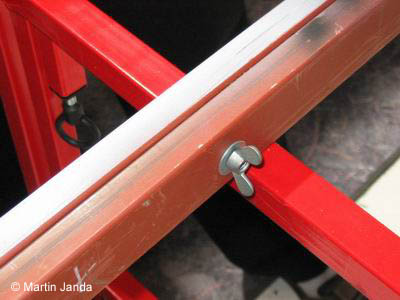
This is the way we planned to joint the steel tubes.
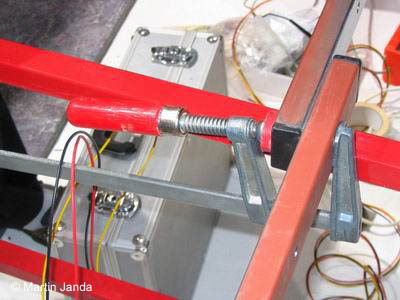
...and as the tubes were slightly too short we did it this way (don't do this at home!). Even this wasn't enough...
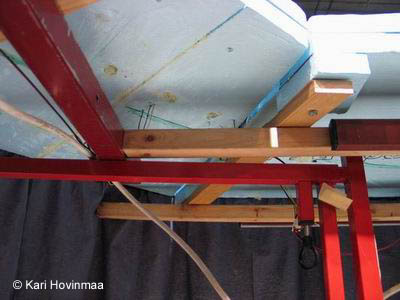
... so on Friday morning we extended the tubes with wood!
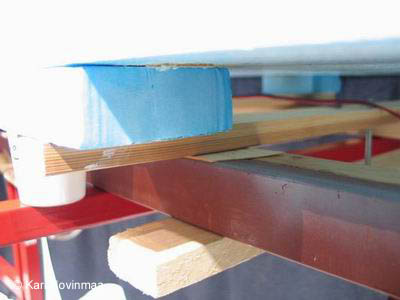
For some reason the module height wasn't correct everywhere. So we needed to shim the modules. The intention was not to have any need for this at setting up!
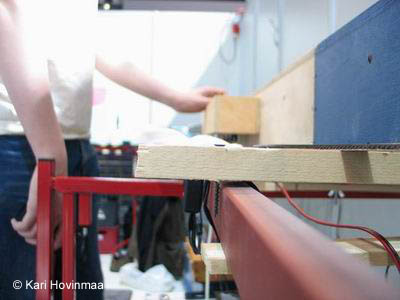
Although the modules were tightened one could still move the modules by pushing from the side. The fiddle yard was locked to steel tubes with screws. We should either return to the idea of using rubber bands under the module cross members as originally planned or at least paint the cross members with latex paint. The paint alone might do the trick!
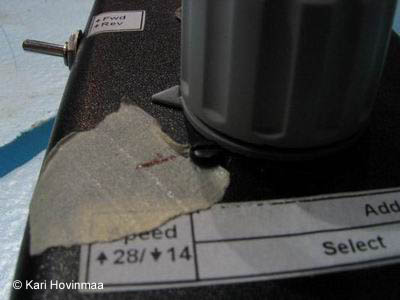
The speed controls (potentiometers) of the IR throttles don't last in the hands of the youngsters. The controllers need to be rebuilt so that we use rotary encoder or at least redesign the software so that open circuit at speed pot will not mean full speed ahead;)
7205 kävijää/visitors
© 1996-2023 Tapiola Parish Model Railway Club / Tapiolan seurakunnan pienoisrautatiekerho, Viimeksi päivitetty / last modified (none). Created with Notepad.
Text, drawings and photos are protected by copyright laws. Technical solutions, methods and source code are public domain only for non commercial purpose. All development has been carried out during our free time, mainly funded from our own pocket and with non selfish goals, so the use of this material for profitable use (including construction for a friend aginst a fee) is forbidden without written permit from the club. The pages contain errors, so, if you use the data given, you do so at your own risk and responsibility. If you further develop material found on these pages you must put it on display without fee e.g. to a freely available web page. We expect a note about this also.
Pages tested with W3C validator -- didn't look good ;)
[YHTEYSTIEDOT] Älä lähetä sähköpostia!
Tekstit, kuvat ja piirokset ovat tekijänoikeuslain suojaamia. Tekniset ratkaisut, menetelmät ja lähdekoodit ovat vapaasti kopioitavissa ja hyödynnettävissä ei-kaupallisissa tarkoituksissa. Kaikki kehitystyö on tehty vapaa-aikana ja pääosin henkilökohtaisilla varoilla eikä hyötymistarkoituksessa, siksi materiaalin käyttö hyötymistarkoituksiin (sisältäen kaverille rahasta rakentamisen!) on kielletty ilman kerhon kirjallista lupaa! Sivuilla esiintyy virheitä. Jos käytät sivujen tietoja hyväksesi, teet sen täysin omalla vastuullasi. Mikäli kehität sivuilla esiettyjä ajatuksia kytkentäkaavioita tai koodia edelleen, on sinun asetettava se maksutta kaikkien saataville esimerkiksi Internetiin. Odotamme vastavuoroisesti tietoa suoritetusta edelleenkehitystyöstä.
Sivut testattu W3C validatorilla -- ei näyttänyt hyvältä ;)